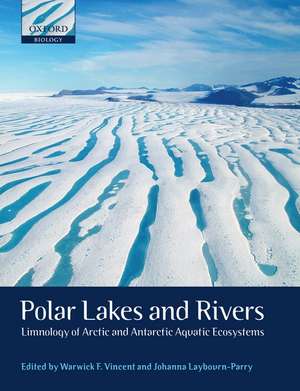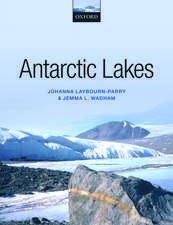Polar Lakes and Rivers: Limnology of Arctic and Antarctic Aquatic Ecosystems
Editat de Warwick F. Vincent, Johanna Laybourn-Parryen Limba Engleză Paperback – 10 sep 2008
Preț: 437.71 lei
Nou
Puncte Express: 657
Preț estimativ în valută:
83.77€ • 90.96$ • 70.36£
83.77€ • 90.96$ • 70.36£
Carte tipărită la comandă
Livrare economică 22 aprilie-06 mai
Preluare comenzi: 021 569.72.76
Specificații
ISBN-13: 9780199213894
ISBN-10: 0199213895
Pagini: 346
Ilustrații: 75 line, 25 black and white halftone illustrations and a 16 page colour plate section
Dimensiuni: 189 x 246 x 18 mm
Greutate: 0.82 kg
Editura: OUP OXFORD
Colecția OUP Oxford
Locul publicării:Oxford, United Kingdom
ISBN-10: 0199213895
Pagini: 346
Ilustrații: 75 line, 25 black and white halftone illustrations and a 16 page colour plate section
Dimensiuni: 189 x 246 x 18 mm
Greutate: 0.82 kg
Editura: OUP OXFORD
Colecția OUP Oxford
Locul publicării:Oxford, United Kingdom
Notă biografică
Prof. Warwick Vincent is Professor of Biology and Canada Research Chair in Aquatic Ecosystem Studies at Laval University, Québec City, Canada. He is a member of the Royal Society of Canada, and honorary member of the Royal Society of New Zealand. His research focuses on aquatic microbial ecology, light and primary production, and ecosystem responses to climate change, with emphasis on Arctic and Antarctic waters. He has served on the editorial boards of Antarctic Science and Polar Biology, and on various research committees and studies. He was inaugural Chair of Canada's National Antarctic Committee. He teaches undergraduate, graduate and field courses in limnology at Laval University, and has been an instructor in the outreach initiative 'Students on Ice' to Antarctica.Prof. Johanna Laybourn-Parry is vice-provost Research at the University of Tasmania, Australia. Prior to that she was Executive Dean of Science at Keele University, UK, and Professor of Environmental Biology at Nottingham University. Her research is undertaken in the Antarctic with the Australian and US Antarctic programmes and in the Arctic at the Natural Environment Research Council Station in Svalbard. Her research interests focus on carbon cycling in polar lakes, protozoan ecophysiology, viral bacterial dynamics, bioprospecting for novel biochemicals, remote sensing of lake environments and biological processes on glaciers. She has published two sole authored books, and 128 peer reviewed articles and reviews. Her work has been funded by the Natural Environment Research Council, the Engineering and Physical Sciences Research Council, the Leverhulme Trust, The European Union, the Royal Society, Industry and logistic support from the Australian Antarctic Science Advisory Committee and NSF.




